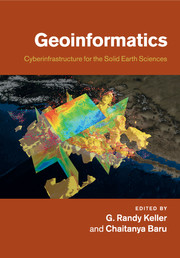Book contents
- Frontmatter
- Contents
- List of contributors
- Preface
- Introduction
- Part I Case studies from other disciplines
- Part II Modeling software and community codes
- 5 Development, verification, and maintenance of computational software in geodynamics
- 6 Parallel finite element modeling of multi-timescale faulting and lithospheric deformation in western USA
- 7 Next-generation plate-tectonic reconstructions using GPlates
- Part III Visualization and data representation
- Part IV Knowledge management and data integration
- Part V Web services and scientific workflows
- Part VI Emerging international and other efforts
- Index
- Plate section
- References
7 - Next-generation plate-tectonic reconstructions using GPlates
from Part II - Modeling software and community codes
Published online by Cambridge University Press: 25 October 2011
- Frontmatter
- Contents
- List of contributors
- Preface
- Introduction
- Part I Case studies from other disciplines
- Part II Modeling software and community codes
- 5 Development, verification, and maintenance of computational software in geodynamics
- 6 Parallel finite element modeling of multi-timescale faulting and lithospheric deformation in western USA
- 7 Next-generation plate-tectonic reconstructions using GPlates
- Part III Visualization and data representation
- Part IV Knowledge management and data integration
- Part V Web services and scientific workflows
- Part VI Emerging international and other efforts
- Index
- Plate section
- References
Summary
Introduction
Plate tectonics is the kinematic theory that describes the large-scale motions and events of the outermost shell of the solid Earth in terms of the relative motions and interactions of large, rigid, interlocking fragments of lithosphere called tectonic plates. Plates form and disappear incrementally over time as a result of tectonic processes. There are currently about a dozen major plates on the surface of the Earth, and many minor ones. The present-day configuration of tectonic plates is illustrated inFigure 7.1. As the interlocking plates move relative to each other, they interact at plate boundaries, where adjacent plates collide, diverge, or slide past each other. The interactions of plates result in a variety of observable surface phenomena, including the occurrence of earthquakes and the formation of large-scale surface features such as mountains, sedimentary basins, volcanoes, island arcs, and deep ocean trenches. In turn, the appearance of these phenomena and surface features indicates the location of plate boundaries. For a detailed review of the theory of plate tectonics, consult Wessel and Müller (2007).
A plate-tectonic reconstruction is the calculation of positions and orientations of tectonic plates at an instant in the history of the Earth. The visualization of reconstructions is a valuable tool for understanding the evolution of the systems and processes of the Earth's surface and near subsurface. Geological and geophysical features may be “embedded” in the simulated plates, to be reconstructed along with the plates, enabling a researcher to trace the motions of these features through time.
- Type
- Chapter
- Information
- GeoinformaticsCyberinfrastructure for the Solid Earth Sciences, pp. 95 - 114Publisher: Cambridge University PressPrint publication year: 2011
References
- 170
- Cited by



